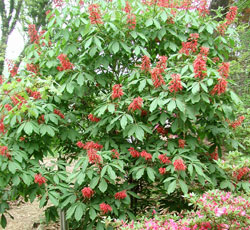Resource Library
Plant of the Week: Red Buckeye
The University of Arkansas System Division of Agriculture does not promote, support or recommend plants featured in "Plant of the Week." Please consult your local Extension office for plants suitable for your region.
Plant of the Week
Red Buckeye
Latin: Aesculus pavia

In our modern age much of the "civilized" world has lost touch with nature. But vestiges of the old, long forgotten relationship with nature linger, often appearing in unexpected places. The buckeye seed spotted when change was being dumped into the basket at the airport x-ray machine was one of these.
Two species of buckeyes occur naturally in Arkansas, with the red buckeye (Aesculus pavia), the most widely distributed and the most often met in gardens. It is a small, low branched, wide spreading tree or large shrub seldom reaching more than 15 feet tall in cultivation but occasionally twice that in the wild.
Red buckeye occurs statewide but is absent from the Ozarks. The yellow flowered Ohio buckeye (A. glabra) occurs in the western Ozarks but is not found in the rest of the state.
Red buckeye has hand-sized palmately compound leaves with five leaflets. Plants break bud early in the season but often are among the first to lose their leaves in late summer. Unlike most other trees, buckeyes only make a single flush of growth in the spring.
At the end of unfurling branches a six inch long spike of flowers appears in midspring. The inch long tubular blossoms have four or five petals and are inserted inside a red, bell-shaped calyx. Hummingbirds often frequent the blooms.
A pair of buckeye seeds appears in late summer in a fig-sized leathery pouch. The dark brown seed are large, smooth and take on a rich luster as they harden and are handled. Wildlife, with the possible exception of squirrels, shun the bitter, poisonous seeds.
Carrying buckeye seeds in your pocket is an old custom. According to Ozark folklorist Vance Randolph, his own doctor, the two most successful bankers in Springfield, MO, a mayor of Kansas City and a governor of Arkansas were all buckeye carriers. Ostensibly, the seeds were carried as a folk remedy to ward off rheumatism, hemorrhoids and other assorted ailments.
But mostly it was considered a lucky charm. The old saying went - "You’ll never find a dead man with a buckeye in his pocket". It is still occasionally met with today amongst the pocket detritus of Arkansans, but as a worry stone, not an amulet.
The tradition appears to be a New World phenomenon, for Gerard in the early 1600’s only warns us that eating European horsechestnut (A. hippocastanum) seeds will set heavy on the stomach and give you "winde". Randolph was told the tradition was handed down from the Osage Indians who used the roots of buckeye as a fish poison. Native tribes also made flour from the starchy, but poisonous seeds. They roasted the seeds amongst the hot stones of a camp fire for a time before extracting the kernel and pounding it into a paste.
The red buckeye grows as an understory tree on benches and along stream banks. Preference is for fertile, moist sites but the tree has considerable drought tolerance once established. It flowers better in full sun, but hot, dry locations may result in late season leaf scorch. It makes a nice specimen plant as it gets older.
Buckeyes are slow growing but precocious, usually flowering in three years from seed. Only fresh seed will germinate, so plant them as soon as ripe in a moist location in the garden or in a gallon size nursery pot. The root appears in the fall, the shoot the following spring.
By: Gerald Klingaman, retired
Extension Horticulturist - Ornamentals
Extension News - May 19, 2006
The University of Arkansas System Division of Agriculture does not maintain lists of retail outlets where these plants can be purchased. Please check your local nursery or other retail outlets to ask about the availability of these plants for your growing area.